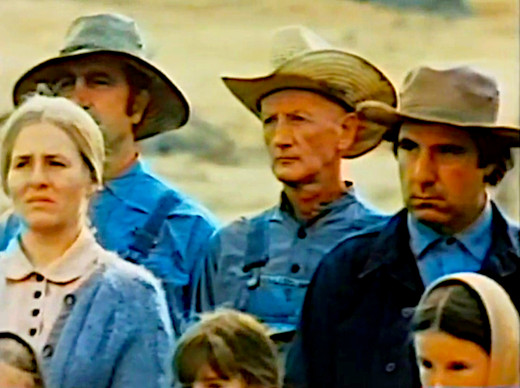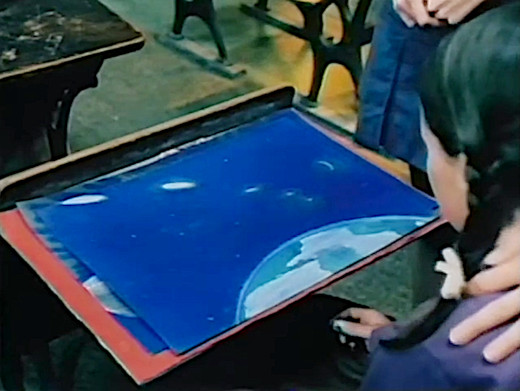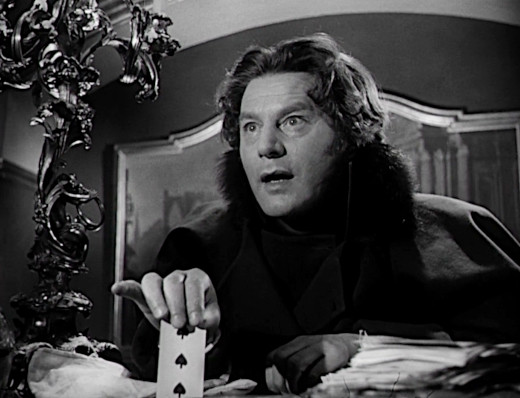Pros: Gentle, cerebral sci-fi that subverts TV movie expectations
Cons: Some character interactions and motivations seem implausible and forced
This is the final entry in a series inspired by a challenge from Barry at Cinematic Catharsis. See the end of this post for more details and my challenge to a new set of bloggers.
A long, long time ago, somewhere between the late Pleistocene era and the invention of the smartphone, I lived practically a stone’s throw from Amish country.
The city I lived and worked in is no tourist destination, but to the south, the “simple” life of the Amish attracts people from far and wide during the summer months. (Of course, it’s anything but simple to forsake modern amenities, grow your own food, be prepared to build or fix almost anything, and maintain strong bonds with family and neighbors, but I digress.)
A trip to Amish country allows us 21st century netizens a break from our ubiquitous screens to taste real food made from scratch, admire crafts and furniture skillfully fashioned by hand, and marvel at the stately unhurriedness of travel by horse and buggy.
It’s the closest thing to actual time travel we have, made all the more intriguing because, unlike such historic destinations as colonial Williamsburg or Mystic Seaport, the locals are the real deal, not paid reenactors who shed their costumes at the end of the day, pop open a canned cocktail and fire up the smart TV to binge Ted Lasso episodes.
But being the real deal (and stubbornly wanting to remain that way), the Amish seem to have achieved a good balancing act, allowing just enough of a sampling of their way of life to satisfy the tourists without being sucked into the voracious maw of technocapitalism.
The People in the 1972 TV movie of the same name look like the Amish and act (to an extent) like the Amish, but they are decidedly not Amish. They live in a secluded valley in the middle of nowhere (looking very much like rural California), and allow only a select few outsiders into their community. These people don’t do tourism.
 |
| "Okay everybody, smile for the camera!" "We ARE smiling." |
One of those outsiders is Melodye Anderson (Kim Darby), a young, emotionally vulnerable school teacher who has dumped her boyfriend and agreed to move to the mysterious community to teach. Melodye herself is something of a voluntary outcast, as she eventually reveals that she decided to make the move to “find herself” amidst the “peace and quiet.”
She finds something alright, but at least initially, it’s not herself. Unsurprisingly, the People are taciturn and the children suppressed. There is a one-room schoolhouse, a former church, that is clean and well cared for, and appears to be the center point of the community.
Melodye’s speech to the assembled townspeople about her philosophy of allowing students the freedom to “explore the world around them in order to discover their full potential” predictably goes over like a lead balloon. She visibly wilts under the withering stares of the parents. The People don’t go in for that New Agey touchy-feely stuff, or music, singing or dancing for that matter. A young town leader, Valency (Diane Varsi) gently tells the naive schoolteacher that she needs to “listen deeply” rather than going off half-cocked, but nonetheless, Melodye dives right in with her modern, liberal approach.
When she has her students introduce themselves by saying what sort of animal they’d like to be, one of them protests that “we’re not supposed to pretend.” Worse still, the youngsters shuffle their feet everywhere they go, as if lifting them for a moment will result in something horrible.
Melodye begins to get it that she’s not in Kansas anymore when one of the girls, Bethie (Johanna Baer), inexplicably starts writhing on the ground, as if her arm is trapped under an invisible weight. Another outsider, Dr. Curtis (William Shatner) is called in, but he is out of his depth, finding no cause for her pain. Valency speaks cryptically of Bethie needing to be “sorted.” She tells the doctor that Bethie’s only chance is to find and treat another local, a boy named Bram, whom they soon discover trapped underneath a tractor that has rolled over. Hmmmmm…
 |
| The People are ruled by the oldest and grumpiest members of the community. |
This isn’t the only oddity Dr. Curtis has noticed in his time spent among the People. He’s curious that no one in town ever seems to get sick, and jokes that if he didn’t also double as a veterinarian, he’d have nothing to do. When Melodye asks him if he’s not just a little unnerved by the locals, he responds that “I’ve learned to respect these people, even when I didn’t have the foggiest idea what they were doing, or why.”
Melodye’s tenure as the town’s school teacher is hanging by a thread, but her nurturing heart has overridden her sense of self-preservation. She senses an untamed spirit in one of the boys, Francher (Chris Valentine), and tries to get him to open up by gifting him a harmonica and quoting Henry David Thoreau about stepping to the beat of a different drummer (helloooo Melodye, are you trying to get fired?).
Little does she know that her gift and encouraging words will lift up Francher, literally as well as figuratively, and eventually uncover the town’s fantastic secret.
At first glance, The People appears to be a suspense thriller with sci-fi overtones. All the elements are there: a vulnerable stranger in a strange land; enigmatic locals with dark secrets to hide, perhaps at all costs; and the gradual unraveling of those secrets.
But despite her stubborn forays into New Age schooling in a decidedly old school community, Melodye is never in any danger from the town elders or anything else. Instead, The People is a flawed, yet affecting study of clashing cultures and the age-old tension between community obligations and the urge to be yourself.
Melodye starts out hesitant and unsure of herself, but as she gets to know the children better, her determination grows to upend the seemingly senseless rules that keep the children from being all that they can be (and this being sci-fi, what they can be is eye-opening).
In contrast, the other outsider, Dr. Curtis is genial and bright, but also ineffectual in the face of an extraordinary situation his science can’t account for. This is not the hard-charging Captain Kirk we’re used to -- it’s Melodye who has all the agency, and she is the one wantonly violating the Prime Directive as the Doc mostly stands around passively observing (although he does get a chance toward the end to exercise his surgical chops).
 |
| Captain Kirk advises Melodye on the hazards of violating the Prime Directive. |
TAKE HEED: THE PEOPLE SHALL GIVE UP THEIR MILD SPOILERS
If there’s a singular flaw in The People, it’s the reactions of the elders to this petite bull in their china shop. Melodye’s actions not only awaken something that can potentially put them all in grave danger, but eventually she is indirectly responsible for a serious injury to one of the children. The locals’ hesitancy in doing anything about her meddling, and a too-abrupt resolution featuring a kumbaya moment of reconciliation seems forced and implausible.
But the film also has its inspired moments, not the least of which is the way in which Melodye finally discovers the People’s secret past. Another concern of the elders is that the children stay grounded in the present, and not try to remember the time before the founding of their little community. Melodye, wanting to throw a monkey wrench into that suppressive business, stimulates the children’s memories by having them draw. The reveal of the People’s backstory through the kids’ art is clever and poignant.
 |
| "That's a beautiful picture Bethie, but the assignment was to draw a horse." |
Towards the end of the film, the idealistic teacher, having inadvertently (?) exposed the People’s secrets to a potentially hostile outer world, glumly admits to Doc Curtis that she feels more of an outsider than ever. When he points out that she can help them share their wisdom and knowledge with humanity, she counters, “And what do you think the outside world will do with that? Probably turn them into a tourist attraction… or maybe they’ll massacre them all this time out of fear and jealousy.”
I can picture a fitting epilogue: The People fire Melodye and bring in Amish consultants to help them figure out how to distract the outsiders with tourism while keeping their real lives private.
Kim Darby, who made a career out of vulnerable, girl-next-door roles, guest starred on a number of hit ‘60s TV shows until vaulting to fame as the preternaturally stubborn Mattie opposite John Wayne’s Rooster Cogburn in the original True Grit (1969).
She made a string of less successful feature films after True Grit, and by 1972 she was back to guesting on TV. In 1973 she played the paranoid lead to perfection in what some consider the preeminent ‘70s made-for-TV horror film, Don’t Be Afraid of the Dark.
In 1972, William Shatner was still relatively fresh from command of the starship Enterprise, but unfortunately the obvious toupee for which he has been ribbed unmercifully was on full display. By the mid-70s he had made several TV movies which are still remembered fondly, including Go Ask Alice (1973), The Horror at 37,000 Feet (1973; see my review here), and Pray for the Wildcats (1974; with Andy Griffith, Robert Reed and Marjoe Gortner). Star Trek fans will fondly remember the first time Shatner and Darby teamed up, in the original series episode “Miri” (1966).
The People was adapted from a popular series of stories by Zenna Henderson. The TV movie, which came out the same year as The Godfather, was executive produced by Francis Ford Coppola under the auspices of Coppola’s American Zoetrope studios. Zoetrope was founded in 1969 and was involved with, among other things, George Lucas’ first feature film THX 1138 and films by international superstars Jean-Luc Godard and Akira Kurosawa. Between The Godfather and The People, it’s hard to imagine two more different films.
 |
| Kim wonders how she ended up in a low-budget TV movie so soon after her breakout role in True Grit. |
Where to find it: Streaming 1 | Streaming 2
Passing the baton in the movie blogger challenge
As I mentioned in the first entry in this series back in January, this was the result of a challenge from Barry at Cinematic Catharsis to review my Top Five underrated/overlooked ‘70s sci-fi TV movies. After all this time, I need to pass on the baton to the next group of bloggers. (Note to my fellow bloggers: although I turned Barry’s challenge into a 5 part series, if you choose to take up the new challenge, please DO NOT feel obligated to follow that lead -- one post will suffice very nicely!)
Dustin from Horror and Sons: Favorite underrated ‘80s horror movies; or Favorite episodes from horror anthologies or TV shows
Mike from Mike’s Movie Room: Favorite Universal horror movies not featuring Frankenstein, Dracula, the Wolf man or the Mummy; or Favorite moments from Universal horror movies
Marianne from Make Mine Film Noir: Favorite noirs set somewhere other than the United States; or Favorite moments from classic noir









